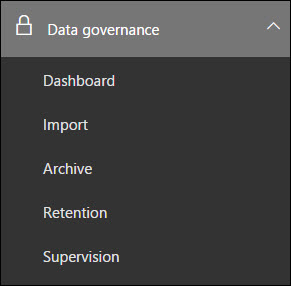Data governance in the Office 365 Security & Compliance Center
Use the data governance features in the Office 365 Security & Compliance Center to import data into your Office 365 organization, archive and retain content in email and documents, and create supervision policies to review internal and 3rd-party communications.
How to get to the Office 365 Data governance features
The Data governance features in Office 365 are accessible by using the Security & Compliance Center. Here's how to get to the page.
To go directly to the Security & Compliance Center:
-
Sign in to Office 365 using your work or school account.
-
In the left pane, select Data governance to see the Data governance features.
To go to the Security & Compliance Center using the Office 365 app launcher:
-
Sign in to Office 365 using your work or school account.
-
Select the app launcher
 in the upper left corner, and then select the Security & Compliance tile.
in the upper left corner, and then select the Security & Compliance tile. -
In the left pane, select Data governance to see the Data governance features.

Data governance features
The following table describes the features that are available under Data governance in the Security & Compliance Center.
| Feature | Description |
| Import PST files to Exchange mailboxes. You can upload the files over the network or copy them to a hard drive and then ship the drive to a Microsoft datacenter. Then you can use the Intelligent Import feature to filter the items in PST files that actually get imported to the target mailboxes. This lets you trim the data that's imported by setting filters that control what data gets imported to Office 365. Tip: You can also import and archive third-party data—from social media platforms, instant messaging platforms, and document collaboration platforms—to mailboxes in your Office 365 organization. After third-party data is imported, you can apply Security & Compliance Center features, such as archiving, retention, and content search to this data. For more information, see Archiving third-party data in Office 365. | |
| Enable or disable a user's archive mailbox, which provide users with an alternate storage location for historical messaging data. When you use Content search in the Security & Compliance Center to search a user's mailbox, their archive mailbox will also be searched. When archive mailboxes are enabled, an archive policy will automatically move messages from a user's primary mailbox to their archive mailbox after a specified period. And users can still access these messages in their archive mailbox. The default archive policy that is assigned to mailboxes moves messages to the archive mailbox two years after the date a message is delivered to the mailbox. Office 365 also provides unlimited storage capacity for archive mailboxes when you enable the auto-expanding archiving feature. So when the storage quota in an archive mailbox is reached, Office 365 automatically increases the size of the archive. For more information, see Overview of unlimited archiving in Office 365. | |
| Manage the lifecycle of email and documents by keeping the content you need and removing content after it's no longer required. While your organization may be required to retain content for a period of time because of compliance, legal, or other business requirements, keeping content longer than required might create unnecessary legal risk. These retention features let you manage how long your organization retains content. | |
| Define supervision policies that capture email and 3rd-party communications in your organization so they can be examined by internal or external reviewers. Reviewers can then use the Supervision add-in for Outlook and Outlook web app to classify these communications, make sure they're compliant with your organization's policies, and escalate questionable material if necessary. |
Nice post.
ReplyDeleteOffice 365 training
Open stack online training
Open stack training
SAP ABAP on Hana online training
SAP ABAP on Hana training
SAP ABAP online training
SAP ABAP training
SAP Basis online training
SAP Basis training
SAP Bods online training
SAP Bods training
SAP BW on Hana online training
SAP BW on Hana training
SAP CS online training
SAP CS training
SAP Fico online training
SAP Fico training
Great article..
ReplyDeleteC training
Data power training
Data Stage training
Im thankful for the article post. Thanks Again. Fantastic.
ReplyDeletedata science training
python training
angular js training
selenium trainings